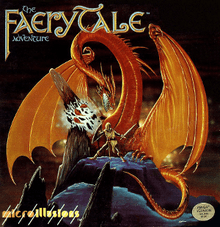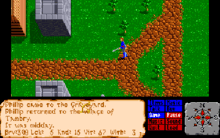The Faery Tale Adventure
| The Faery Tale Adventure | |
|---|---|
 Cover art by Ed Kline | |
| Developer(s) | MicroIllusions |
| Publisher(s) |
MicroIllusions Electronic Arts (Genesis) |
| Designer(s) | David Joiner |
| Series | Faery Tale Adventure |
| Platform(s) |
Amiga (original) Commodore 64, MS-DOS, Genesis, Macintosh |
| Release | 1987 |
| Genre(s) | Action RPG[1] |
| Mode(s) | Single-player |
The Faery Tale Adventure is a 1987 action role-playing video game designed by David Joiner and published by MicroIllusions for the Amiga, and later ported for the Commodore 64, MS-DOS, Genesis, and Macintosh. The MS-DOS version is titled The Faery Tale Adventure: Book I.[2] The initial version was produced for the AMIGA 1000, which came widely available around 1986, and featured the largest game world to that date.[3]
Gameplay

The game's gameplay resembles that of Ultima VII (1992). At the time of its release, the game featured the largest game world yet (over 17,000 computer screens) with no loadings.
Each playable character has his strengths and weaknesses—Julian is a brave fighter, Phillip has luck and cleverness, and Kevin is gentle and kind. Each of these attributes would affect vital game stats and the success of the quest:
- A high Bravery score contributes to Vitality ("Vit"), the characters health. It can be increased by slaying enemies.
- Luck determines the number of times particular brother can be brought back from death if he is killed during the quest. If Luck runs out, the next brother must take up the quest.
- Kindness is important for certain key chapters in the game. It can be increased by acts of kindness (such as giving alms to beggars).
The technique used to store such a huge world involved creating small-sized maps out of small shape-sized blocks. Those small maps were reused and fit together seamlessly to form larger areas. Loading is asynchronous, and will happen when nearing the boundary of an area, without affecting the smooth scrolling, animation, and music.
Design
David Joiner who designed The Faery Tale Adventure, also was responsible for the audio of Defender of the Crown II (1993), engineering for SimCity 4: Rush Hour (2003), and more recently in 2014 contributed with his skills to The Sims 2: Ultimate Collection.[4]
Plot
The game is based around the quest of three brothers to retrieve the talisman stolen by the forces of evil and return it to their home village Tambry in the country of Holm. The player begins as Julian, the eldest of the three brothers; if unsuccessful with this character, they would then take control of Philip, the next oldest, then finally the youngest of the three, Kevin. Next to recovering the talisman, which is kept by an evil necromancer, the player must complete a number of additional tasks which ultimately prove vital to the quest - save the king's daughter, gain the aid of a sea turtle, and kill an evil witch in her castle - and gather a number of artefacts which enable access to the strange dimension in which the necromancer resides.[5][6][7]
History
Like most MicroIllusions games, this game was first released on the Amiga and then ported to other systems. Eventually it was released for the Commodore 64 and DOS, although the graphics for these ports were of substantially lower quality due to hardware limitations. The Amiga version displays two screens as seen in the screenshot, one "lowres" 320 and one "hires" 640 pixels wide, allowing 64 + 16 colors. In 1988, a port was developed for the Macintosh. The 256 color graphics for the Macintosh port were quite advanced (easily surpassing the original Amiga version of the game). Unfortunately, the only color Macintosh model at the time was the Macintosh II, which was prohibitively expensive for a successful gaming platform. The Macintosh port was never released, but a working beta was completed[8] before the development was cancelled. Eventually New World Computing acquired MicroIllusions and in 1991 ported the game to the Mega Drive/Genesis. This version was published by Electronic Arts.
Reception
A review in Computer Gaming World described the game's user interface as natural and simple, while still being an impressive and playable game.[9] The magazine stated that the Sega Genesis version "subtly improved on the original", such as a better teleportation system, while maintaining virtues such as excellent graphics.[10] Dragon gave the computer game 4 1/2 out of 5 stars,[11] and 4 out of 5 stars for the Genesis version.[12] In 1996 Computer Gaming World ranked it as the 63rd best game of all time, calling it "real time adventure at its Amiga best."[13]
Legacy
The sequel, Halls of the Dead: Faery Tale Adventure II, was developed by The Dreamers Guild and released by Encore for MS-DOS and Windows in 1997. Its gameplay and graphics resemble Ultima VIII: Pagan. An Amiga port was under development, but it was cancelled upon the bankruptcy of publisher Hollyware Entertainment.
References
- ↑ The Faery Tale Adventure at AllGame
- ↑ "The Faery Tale Adventure: Book I (1987) MS-DOS box cover art". MobyGames. Blue Flame Labs. Retrieved 21 December 2015.
- ↑ "The Faery Tale Life of MicroIllusions". The Digital Antiquarian. 2015.
- ↑ "David Joiner". MobyGames.
- ↑ "MOCAGH.ORG: Questbusters: qbustersV4". Archive.org. Retrieved 8 June 2016.
- ↑ "Commodore User Magazine Issue 57". Archive.org. Retrieved 8 June 2016.
- ↑ "The Faery Tale Adventure (PC) cheat codes, hints, and help". Gamewinners.com. Retrieved 8 June 2016.
- ↑ Macintosh screen capture of The Faery Tale Adventure
- ↑ Wagner, Roy (February 1988). "The Faery Tale Adventure". Computer Gaming World. pp. 46–47, 50, 53.
- ↑ Olafson, Peter (October 1991). ""Console"ing Your Imagination With the Might and Magic of a Faery Tale Adventure". Computer Gaming World. p. 68. Retrieved 18 November 2013.
- ↑ Lesser, Hartley; Lesser, Patricia; Lesser, Kirk (April 1988). "The Role of Computers". Dragon (132): 80–85.
- ↑ Lesser, Hartley; Lesser, Patricia; Lesser, Kirk (November 1991). "The Role of Computers". Dragon (175): 57–66.
- ↑ "150 Best Games of All Time". Computer Gaming World. November 1996. pp. 64–80. Retrieved 25 March 2016.